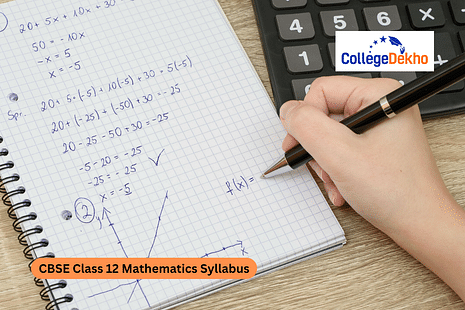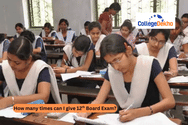CBSE Class 12 Mathematics Syllabus 2026 has been released by the Central Board of Secondary Education @cbseacademic.nic.in. You can find the direct link to download the CBSE 12th Mathematics curriculum here!


Never Miss an Exam Update
CBSE Class 12 Mathematics Syllabus 2026 has been released by the Central Board of Secondary Education. The theory paper of CBSE class 12 Mathematics will be held for 80 marks, and the remaining 20 marks will be allotted for the internal assessments. CBSE Class 12 Syllabus 2026 for Mathematics comprises a total of 6 units, which are further divided into 13 chapters. Per the CBSE 12th Maths syllabus 2026, unit 3 (Calculus) will carry the maximum weightage of 35 marks. Following this, the next major weightage-carrying units are Vectors and Algebra, each carrying a weightage of 14 and 10, respectively.
In the theory paper, no overall choice will be given in the question paper. However, all the sections will have 33% of internal choices. Moreover, the CBSE board will retain the CBSE class 12 Math deleted syllabus for this academic session as well. Students appearing for the upcoming CBSE 12th Board 2026 exams can also download the CBSE Class 12 Mathematics Exam Pattern 2026 from the official website of the CBSE board - cbseacademic.nic.in. Read the entire article to know more about the CBSE 12th Mathematics syllabus 2026.
Also Read- CBSE Class 12 Maths Previous Year Question Paper
CBSE Class 12 Mathematics Syllabus 2026 PDF Download
Download the latest CBSE Class 12 Mathematics Syllabus 2026 PDF by clicking on the link given below:
CBSE Class 12 Mathematics Syllabus 2026 Course Structure
The CBSE class 12 Maths examination will be conducted for 3 hours, from 10:30 AM to 1:30 PM. The Maths question paper will be divided into five sections, Section A, Section B, Section C, Section D, and Section E. Refer to the table below to have an idea of the course structure of the CBSE 12th Maths syllabus 2026:
No. | Units | Marks |
|---|---|---|
I | Relations and Functions | 08 |
II | Algebra | 10 |
III | Calculus | 35 |
IV | Vectors and Three-Dimensional Geometry | 14 |
V | Linear Programming | 05 |
VI | Probability | 08 |
CBSE Class 12 Mathematics Syllabus 2026: Chapter-Wise
The chapters and topics that are included in each unit of the CBSE Class 12 Maths Syllabus 2026 are given below:
Unit I: Relations and Functions
This unit comprises the following chapters and topics:
- Relations and Functions [15 Periods]
Types of relations: reflexive, symmetric, transitive, and equivalence relations. One-to-one and onto functions.
- Inverse Trigonometric Functions [15 Periods]
Definition, range, domain, principal value branch. Graphs of inverse trigonometric functions.
Unit II: Algebra
- Matrices [25 Periods]
Concept, notation, order, equality, types of matrices, zero and identity matrix, transpose of a matrix, symmetric and skew-symmetric matrices. Operations on matrices: Addition and multiplication and multiplication with a scalar. Simple properties of addition, multiplication, and scalar multiplication. Noncommutativity of multiplication of matrices and existence of non-zero matrices whose product is the zero matrix (restricted to square matrices of order 2). Invertible matrices and proof of the uniqueness of inverse, if it exists; (Here all matrices will have real entries).
- Determinants [25 Periods]
Determinant of a square matrix (up to 3 x 3 matrices), minors, co-factors and applications of determinants in finding the area of a triangle. Adjoint and inverse of a square matrix. Consistency, inconsistency, and number of solutions of a system of linear equations by examples, solving a system of linear equations in two or three variables (having unique solution) using the inverse of a matrix.
Unit-III: Calculus
- Continuity and Differentiability [20 Periods]
Continuity and differentiability, chain rule, derivative of inverse trigonometric functions, like sin-1 x, cos-1 x, and tan-1 x, derivative of implicit functions. Concept of exponential and logarithmic functions. Derivatives of logarithmic and exponential functions. Logarithmic differentiation, a derivative of functions expressed in parametric forms. Second-order derivatives.
- Applications of Derivatives [10 Periods]
Applications of derivatives: rate of change of quantities, increasing/decreasing functions, maxima, and minima (first derivative test motivated geometrically and second derivative test given as a provable tool). Simple problems (that illustrate basic principles and understanding of the subject as well as real-life situations).
- Integrals [20 Periods]
Integration as the inverse process of differentiation. Integration of a variety of functions by substitution, by partial fractions, and by parts, Evaluation of simple integrals of the following types and problems based on them.
Fundamental Theorem of Calculus (without proof). Basic properties of definite integrals and evaluation of definite integrals.
- Applications of the Integrals [15 Periods]
Applications in finding the area under simple curves, especially lines, circles/ parabolas/ellipses (in standard form only).
- Differential Equations [15 Periods]
Definition, order and degree, general and particular solutions of a differential equation. Solution of differential equations by method of separation of variables, solutions of homogeneous differential equations of first order and first degree. Solutions of linear differential equation of the type:
dy dx + py = q, where p and q are functions of x or constants. dx dy + px = q, where p and q are functions of y or constants.
Unit-IV: Vectors and Three-Dimensional Geometry
- Vectors [15 Periods]
Vectors and scalars, magnitude and direction of a vector. Direction cosines and direction ratios of a vector. Types of vectors (equal, unit, zero, parallel and collinear vectors), position vector of a point, negative of a vector, components of a vector, addition of vectors, multiplication of a vector by a scalar, position vector of a point dividing a line segment in a given ratio. Definition, Geometrical Interpretation, properties and application of scalar (dot) product of vectors, vector (cross) product of vectors.
- Three-dimensional Geometry [15 Periods]
Direction cosines and direction ratios of a line joining two points. Cartesian equation and vector equation of a line, skew lines, shortest distance between two lines. Angle between two lines.
Unit-V: Linear Programming
- Linear Programming [20 Periods]
Introduction, related terminology such as constraints, objective function, optimization, graphical method of solution for problems in two variables, feasible and infeasible regions (bounded or unbounded), feasible and infeasible solutions, optimal feasible solutions (up to three non-trivial constraints).
Unit-VI: Probability
- Probability [30 Periods]
Conditional probability, multiplication theorem on probability, independent events, total probability, Bayes’ theorem, Random variable, and its probability distribution, mean of random variable.
Also Read- CBSE Class 12 Math Sample Paper 2026
CBSE Class 12 Mathematics Deleted Syllabus 2026
The topics that were excluded from the CBSE class 12 Mathematics syllabus in 2022 will be deleted in the academic session 2026 as well. Go through the deleted portion of the CBSE class 12 Maths syllabus 2026:
Chapter Name | Deleted Topics |
|---|---|
Relations and Functions | Composite functions, inverse of a function |
Inverse Trigonometric Functions | Elementary properties of inverse trigonometric functions |
Matrices | Concept of elementary row and column operations |
Determinants | Properties of determinants |
Continuity and Differentiability | Derivative of composite function, Rolle’s and Lagrange’s Mean Value, theorems (without proof) and their geometric interpretation |
Applications of Derivatives | Tangents and Normals, use of derivatives in approximation |
Integrals | Definite integrals as a limit of a sum |
Applications of Integrals | Area between any one of the two curves |
Vectors | Scalar triple product of vectors |
Three Dimensional Geometry | Coplanar lines, cartesian and vector equation of a plane, angle between two lines, two planes, a line and a plane, distance of a point from a plane |
Linear Programming | Different types of linear programming problems, mathematical formulation of L.P. problems, variance of random variable |
CBSE will release the detailed CBSE 12th Date Sheet 2026 in the last week of December 2025, tentatively. You are advised to complete the CBSE Class 12 syllabus 2026 at least 2 months before the exam begins and dedicate the time to solving the model test papers.
Are you feeling lost and unsure about what career path to take after completing 12th standard?
Say goodbye to confusion and hello to a bright future!

FAQs
There will be at most 38 questions in the CBSE class 12th Mathematics theory paper. Moreover, there will be no overall choice, however, 33% of internal choices will be given in the paper.
There are a total of 6 units in the CBSE Class 12 Mathematics Syllabus 2026. These 6 units are again divided into 13 chapters.
You can find the CBSE class 12 Mathematics Syllabus 2024-25 on the CBSE Board’s official website. You can also check and download the detailed syllabus from this page.
The Unit 3 Calculus carry the maximum weightage of 35 marks in the CBSE Class 12 Mathematics Syllabus 2026.
CBSE Board will continue with the 30% reduced CBSE Class 12 Mathematics Syllabus 2026, this year as well. The board has deleted topics from around 11 chapters.
The Central Board of Secondary Education has released the CBSE Class 12 Mathematics Syllabus 2026 on its official website. It includes 7 units, namely Relations and Functions, Algebra, Calculus, Vectors and Three-Dimensional Geometry, Linear Programming, and Probability.
Was this article helpful?






















